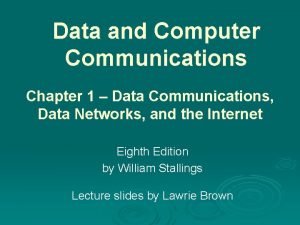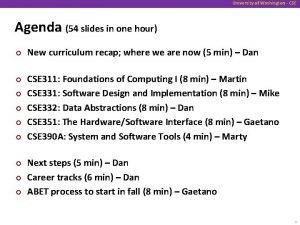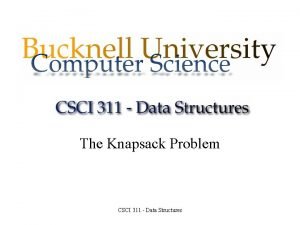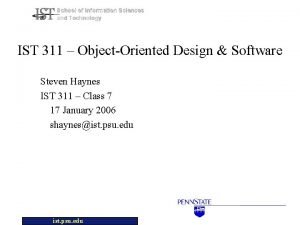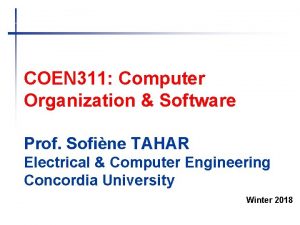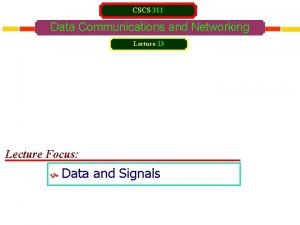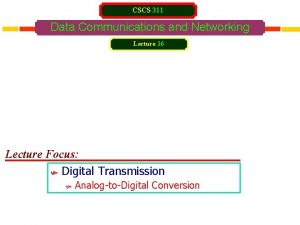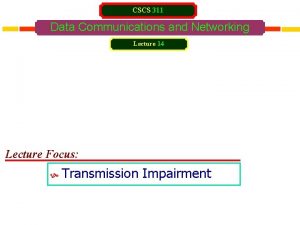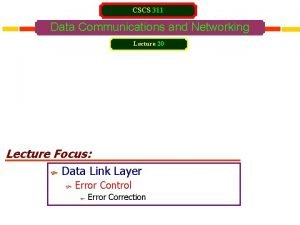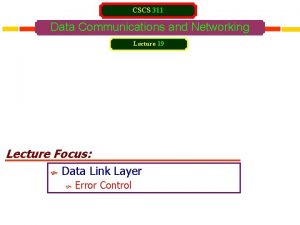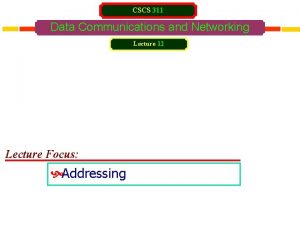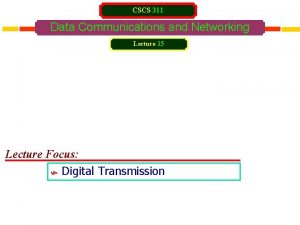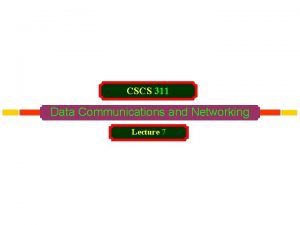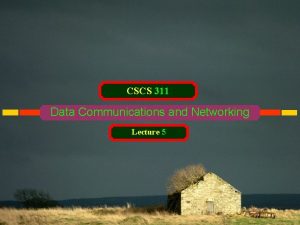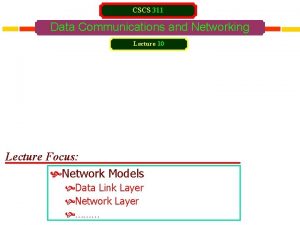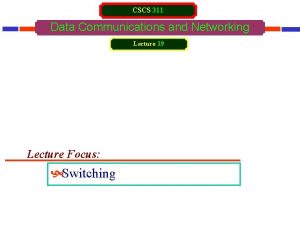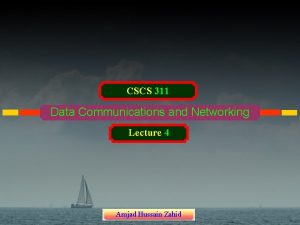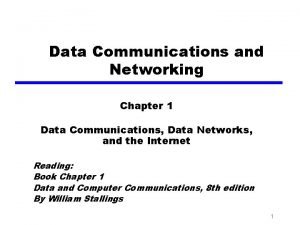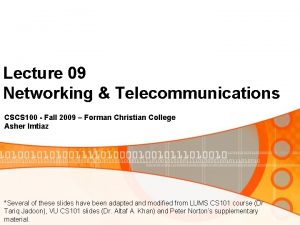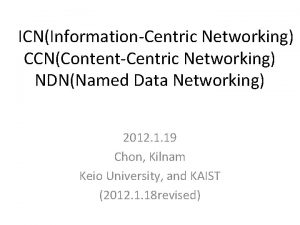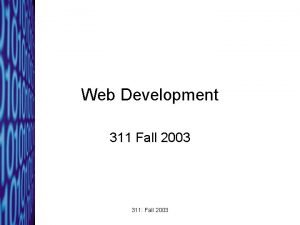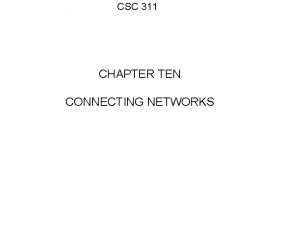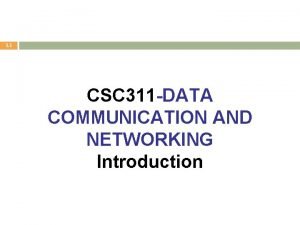CSCS 311 Data Communications and Networking Lecture 22

























- Slides: 25

CSCS 311 Data Communications and Networking Lecture 22 Lecture Focus: Data Link Layer Data Link Control

Data Link Control PROTOCOLS For Noiseless Channel Simplest Stop-and-Wait For Noisy Channel Stop-and-Wait ARQ Go-Back-N ARQ Selective Repeat ARQ Today’s Discussion

Data Link Control PROTOCOLS: NOISY CHANNELS Go-Back-N ARQ Protocol Pipelining It is very useful that a task is begun before the previous task has ended. This is known as pipelining. There is no pipelining in Stop-and-Wait ARQ because we need to wait for a frame to reach the destination and be acknowledged before the next frame can be sent. Pipelining does apply to other two Noisy channel protocols: Several frames can be sent before we receive news about the previous frames. Pipelining improves the efficiency of the transmission.

Data Link Control PROTOCOLS: NOISY CHANNELS Go-Back-N ARQ Protocol To improve the efficiency of transmission, multiple frames must be in transition while waiting for acknowledgment. We want to keep the channel busy while the sender is waiting for acknowledgment. In Go-Back-N ARQ protocol: We can send several frames before receiving acknowledgments. We keep a copy of these frames until the acknowledgments arrive.

Data Link Control PROTOCOLS: NOISY CHANNELS Go-Back-N ARQ Protocol Sequence Numbers Frames from a sender station are numbered sequentially. As we need to include the sequence number of each frame in the header, we need to set a limit. If the header of the frame allows m bits for the sequence number, the sequence numbers range from 0 to 2 m - 1. For example, if m is 4, the only sequence numbers are 0 through 15 inclusive. We can repeat the sequence. So the sequence numbers are: 0, 1, 2, 3, 4, 5, 6, 7, 8, 9, 10, 11, 12, 13, 14, 15, 0, 1, 2, 3, 4, 5, 6, 7, 8, 9, 10, 11, . . . In other words, the sequence numbers are modulo-2 m.

Data Link Control PROTOCOLS: NOISY CHANNELS Go-Back-N ARQ Protocol Sliding Window Sliding window defines the range of sequence numbers. The sender and receiver need to deal with only part of the possible sequence numbers: The range which is the concern of the sender is called the send sliding window. The range that is the concern of the receiver is called the receive sliding window.

Data Link Control PROTOCOLS: NOISY CHANNELS Go-Back-N ARQ Protocol Sliding Window Send sliding window Send window is an imaginary box covering the sequence numbers of the data frames which can be in transit. In each window position, some of these sequence numbers define the frames that have been sent; others define those that can be sent. The maximum size of the window is 2 m – 1. Window size may be fixed and set to the maximum value, but some protocols may have a variable window size.

Data Link Control PROTOCOLS: NOISY CHANNELS Go-Back-N ARQ Protocol Sliding Window Send sliding window Figure below shows a sliding window of size 15 (m = 4). Send window before sliding

Data Link Control PROTOCOLS: NOISY CHANNELS Go-Back-N ARQ Protocol Sliding Window The window at any time divides the possible sequence numbers into four regions: 1. First region, from the far left to the left wall of the window, defines the sequence numbers belonging to frames already acknowledged. Sender does not worry about these frames and keeps no copies of them. 2. Second region defines the range of sequence numbers belonging to the frames that are sent and have an unknown status. Sender needs to wait to find out if these frames have been received or were lost. We call these outstanding frames. 3. Third range defines the range of sequence numbers for frames that can be sent; however, the corresponding data packets have not yet been received from the network layer. 4. Fourth region defines sequence numbers that cannot be used until the window slides.

Data Link Control PROTOCOLS: NOISY CHANNELS Go-Back-N ARQ Protocol Sliding Window Three variables define window size and location at any time: Sf (send window, the first outstanding frame) Sequence number of the first (oldest) outstanding frame. Sn (send window, the next frame to be sent) Sequence number that will be assigned to the next frame to be sent. Ssize (send window, size). Defines the size of the window

Data Link Control PROTOCOLS: NOISY CHANNELS Go-Back-N ARQ Protocol Sliding Window Figure below shows how a send window can slide one or more slots to the right when an acknowledgment arrives from the other end. The acknowledgments in this protocol are cumulative, meaning that more than one frame can be acknowledged by an ACK frame. In this figure, frames 0, 1, and 2 are acknowledged, so the window has slid to the right three slots. Note that the value of Sf is 3 because frame 3 is now the first outstanding frame. The send window can slide one or more slots when a valid acknowledgment arrives.

Data Link Control PROTOCOLS: NOISY CHANNELS Go-Back-N ARQ Protocol Sliding Window Send window after sliding

Data Link Control PROTOCOLS: NOISY CHANNELS Go-Back-N ARQ Protocol Sliding Window Receive sliding window The receive window makes sure that the correct data frames are received and that the correct acknowledgments are sent. The size of the receive window is always 1. The receiver is always looking for the arrival of a specific frame. Any frame arriving out of order is discarded and needs to be resent. Figure below shows the receive window. The receive window has one single variable Rn. Window slides when a correct frame has arrived; sliding occurs one slot at a time.

Data Link Control PROTOCOLS: NOISY CHANNELS Go-Back-N ARQ Protocol Sliding Window Receive sliding window Receive window after sliding

Data Link Control PROTOCOLS: NOISY CHANNELS Go-Back-N ARQ Protocol Sliding Window Receive sliding window Sequence numbers to the left of the window belong to the frames already received and acknowledged. Sequence numbers to the right of this window define the frames that cannot be received. Any received frame with a sequence number in these two regions is discarded. Only a frame with a sequence number matching the value of Rn is accepted and acknowledged. The receive window also slides, but only one slot at a time. When a correct frame is received (and a frame is received only one at a time), the window slides.

Data Link Control PROTOCOLS: NOISY CHANNELS Go-Back-N ARQ Protocol Sliding Window Receive sliding window Timers Although there can be a timer for each frame that is sent, in this protocol we use only one. The reason is that the timer for the first outstanding frame always expires first; we send all outstanding frames when this timer expires. Acknowledgment The receiver sends a positive acknowledgment if a frame has arrived safe and sound and in order. If a frame is damaged or is received out of order, receiver is silent and will discard all subsequent frames until it receives the one it is expecting. The silence of the receiver causes the timer of the unacknowledged frame at the sender site to expire. This causes the sender to go back and resend all frames, beginning with the one with the expired timer. The receiver does not have to acknowledge each frame received. It can send one cumulative acknowledgment for several frames.

Data Link Control PROTOCOLS: NOISY CHANNELS Go-Back-N ARQ Protocol Sliding Window Receive sliding window Resending a Frame When the timer expires, the sender resends all outstanding frames. Example: Suppose the sender has already sent frame 6, but the timer for frame 3 expires. This means that frame 3 has not been acknowledged. The sender goes back and sends frames 3, 4, 5, and 6 again. That is why the protocol is called Go-Back-N ARQ.

Data Link Control PROTOCOLS: NOISY CHANNELS Sliding Window Sender sliding window Go-Back-N ARQ Protocol

Data Link Control PROTOCOLS: NOISY CHANNELS Sliding Window Receiver sliding window Go-Back-N ARQ Protocol

Data Link Control PROTOCOLS: NOISY CHANNELS Sliding Window Normal Operation Go-Back-N ARQ Protocol

Data Link Control PROTOCOLS: Lost Frame NOISY CHANNELS Go-Back-N ARQ Protocol

Data Link Control PROTOCOLS: NOISY CHANNELS Go-Back-N ARQ Protocol Sender Window Size of the sender window must be < 2 m. Size of the receiver window is always 1.

Data Link Control PROTOCOLS: NOISY CHANNELS Go-Back-N sender algorithm Go-Back-N ARQ Protocol

Data Link Control PROTOCOLS: NOISY CHANNELS Go-Back-N Receiver algorithm Go-Back-N ARQ Protocol

Data Link Control PROTOCOLS: NOISY CHANNELS Stop-and-Wait ARQ Go-Back-N ARQ Selective Repeat ARQ Self Study
 Cscs
Cscs Business data communications and networking
Business data communications and networking Business data communication and networking
Business data communication and networking Introduction to data communications and networking
Introduction to data communications and networking Business data communications and networking
Business data communications and networking Sdn overview
Sdn overview Crisis communications lecture
Crisis communications lecture 01:640:244 lecture notes - lecture 15: plat, idah, farad
01:640:244 lecture notes - lecture 15: plat, idah, farad Data communication and networking assignment questions
Data communication and networking assignment questions Telecommunication meaning
Telecommunication meaning Data and computer communications 10th edition
Data and computer communications 10th edition Data & computer communications
Data & computer communications Data and computer communications
Data and computer communications Simplified data communication model
Simplified data communication model Jellyfish networking data centers randomly
Jellyfish networking data centers randomly Hpe data center networking
Hpe data center networking Load balancer gartner 2015
Load balancer gartner 2015 Uw cse 312
Uw cse 312 Art 294 a 311 novo cpc
Art 294 a 311 novo cpc Csci 311
Csci 311 College of information sciences and technology
College of information sciences and technology Round 372 to the nearest 10
Round 372 to the nearest 10 Psyc 311
Psyc 311 Rtca do-347
Rtca do-347 Rpv311
Rpv311 Coen 311
Coen 311












